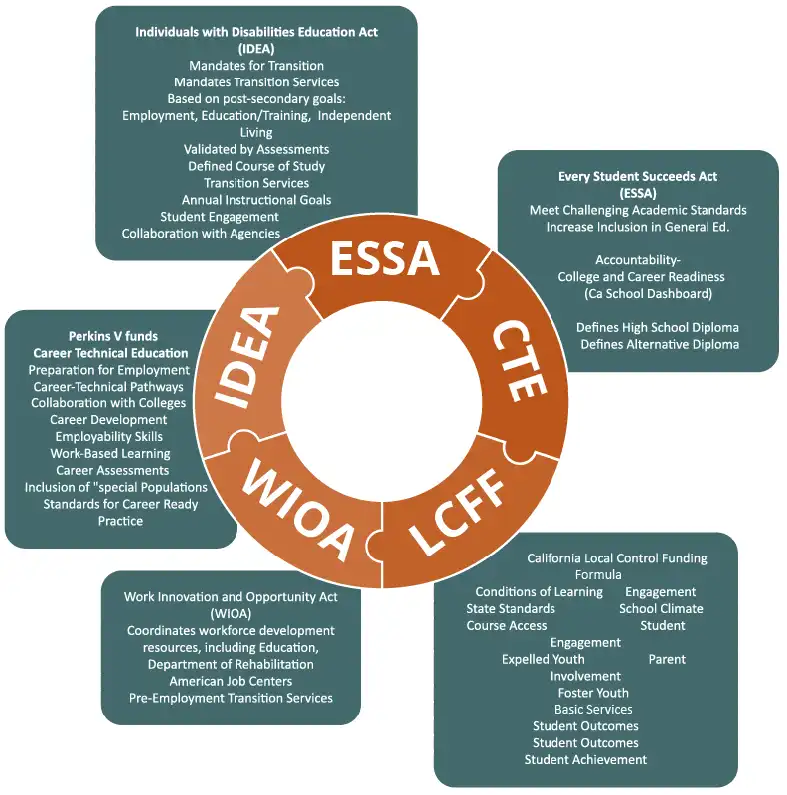Federal and State Guidance
Secondary Transition Services as Defined in IDEA
Under the Individuals with Disabilities Education Act (IDEA), transition is a coordinated set of activities designed to help students with disabilities move successfully from school to postsecondary education, employment, and independent living. According to 34 C.F.R. § 300.43, transition services must be based on the student’s individual needs, strengths, preferences, and interests, and include instruction, related services, community experiences, employment preparation, and, when appropriate, daily living skills. The goal is to ensure students are equipped with the necessary skills and support to achieve meaningful post-school outcomes (IDEA, 20 U.S.C. § 1401(34)).
Definition of Transition Services
The term "transition services," as defined under the Individuals with Disabilities Education Act (IDEA), refers to a coordinated set of activities for a child with a disability that:
- Is designed to be within a results-oriented process, focused on improving the academic and functional achievement of the child to facilitate their movement from school to post-school activities. These activities include:
- Postsecondary education,
- Vocational education,
- Integrated employment (including supported employment),
- Continuing and adult education,
- Adult services,
- Independent living, and
- Community participation.
- Is based on the individual child's needs, taking into account their strengths, preferences, and interests. It includes:
- Instruction,
- Related services,
- Community experiences,
- Development of employment and other post-school adult living objectives, and
- If appropriate, acquisition of daily living skills and functional vocational evaluation.
- Includes collaboration with other agencies:
- With the consent of the parents or the child (if the child has reached the age of majority), the public agency must invite a representative of any participating agency likely to be responsible for providing or paying for transition services.
Key Requirements:
- Transition services must be included in the first Individualized Education Program (IEP) that is in effect when the child turns 16 (or younger if determined appropriate by the IEP team) and must be updated annually.
- The IEP must include measurable postsecondary goals based on age-appropriate assessments related to training, education, employment, and, where appropriate, independent living skills. It must also specify the transition services (including the course of study) needed to help the child achieve these goals.
California State-Specific Guidance
California-Specific Update (Effective July 1, 2025):
- Assembly Bill 438: Transition services and measurable postsecondary goals will be included in the IEP by the time the student begins high school, if determined appropriate by the IEP team.
- While not explicitly required, starting transition planning in 8th grade can help ease the move into high school by giving students, families, and charter school teams more time to explore academic programs, work-based learning opportunities, and course pathways before enrollment. It’s important to clarify that in this context, "transition planning" explicitly includes the creation of an Individual Transition Plan (ITP) as defined in SEIS since the term alone might not be interpreted as encompassing the ITP.
- If the IEP team determines that the pupil would benefit from the postponement of appropriate measurable postsecondary goals and transition services until 16 years of age, rather than when the pupil begins their high school experience, the IEP team is encouraged to justify the basis for that postponement.
California Education Code § 56462 further enhances transition services, requiring:
- Development and dissemination of in-service training programs and resource materials,
- Clearly defined roles and responsibilities in the transition process,
- Implementation of vocational education curricula,
- Active participation of families in planning and implementation, and
- Coordination with specialized programs serving students facing barriers to successful transition.
These updates emphasize the importance of a personalized, collaborative approach to ensure students with disabilities successfully transition to adulthood, equipped with the skills and support they need for postsecondary success.
Federal and State Legislation Aligned with Transition
A comprehensive approach to transition planning for students with disabilities is supported by key federal and state frameworks—including IDEA, ESSA, CTE, WIOA, and LCFF—which together ensure legal mandates, equitable funding, career readiness, interagency collaboration, and access to meaningful postsecondary opportunities.

